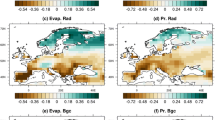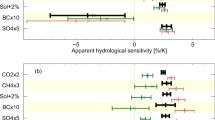Abstract
Vegetation is a major component of the climate system because of its controls on the energy and water balance over land. This functioning changes because of the physiological response of leaves to increased CO2. A climate model is used to compare these changes with the climate changes from radiative forcing by greenhouse gases. For this purpose, we use the Community Earth System Model coupled to a slab ocean. Ensemble integrations are done for current and doubled CO2. The consequent reduction of transpiration and net increase of surface radiative heating from reduction in cloudiness increases the temperature over land by a significant fraction of that directly from the radiative warming by CO2. Large-scale atmospheric circulation adjustments result. In particular, over the tropics, a low-level westerly wind anomaly develops associated with reduced geopotential height over land, enhancing moisture transport and convergence, and precipitation increases over the western Amazon, the Congo basin, South Africa, and Indonesia, while over mid-latitudes, land precipitation decreases from reduced evapotranspiration. On average, land precipitation is enhanced by 0.03 mm day−1 (about 19 % of the CO2 radiative forcing induced increase). This increase of land precipitation with decreased ET is an apparent negative feedback, i.e., less ET makes more precipitation. Global precipitation is slightly reduced. Runoff increases associated with both the increased land precipitation and reduced evapotranspiration. Examining the consistency of the variations among ensemble members shows that vegetation feedbacks on precipitation are more robust over the tropics and in mid to high latitudes than over the subtropics where vegetation is sparse and the internal climate variability has a larger influence.
















Similar content being viewed by others
References
Ainsworth EA, Long SP (2005) What have we learned from 15 years of free-air CO2 enrichment (FACE)? A meta-analytic review of the response of photosynthesis, canopy properties and plant production to rising CO2. New Phytol 165:351–372. doi:10.1111/j.1469-8137.2004.01224.x
Ainsworth EA, Rogers A (2007) The response of photosynthesis and stomatal conductance to rising [CO2]: mechanisms and environmental interactions. Plant Cell Environ 30:258–270. doi:10.1111/j.1365-3040.2007.01641.x
Alkama R, Kageyama M, Ramstein G (2010) Relative contributions of climate change, stomatal closure, and leaf area index changes to 20th and 21st century runoff change: a modelling approach using the Organizing Carbon and Hydrology in Dynamic Ecosystems (ORCHIDEE) land surface model. J Geophys Res 115:D17112. doi:10.1029/2009JD013408
Andrews T, Doutriaux-Boucher M, Boucher O, Forster PM (2011) A regional and global analysis of carbon dioxide physiological forcing and its impact on climate. Clim Dyn 36:783–792. doi:10.1007/s00382-010-0742-1
Ball JT, Woodrow IE, Berry JA (1987) A model predicting stomatal conductance and its contribution to the control of photosynthesis under different environmental conditions. In: Biggins J (ed) Progress in photosynthesis research, vol 4. Martinus Nijhoff, Dordrecht, Netherlands, pp 221–224
Betts AK (2004) Understanding hydrometeorology using global models. Bull Am Meteorol Soc 85:1673–1688
Betts AK, Chiu JC (2010) Idealized model for changes in equilibrium temperature, mixed layer depth, and boundary layer cloud over land in a doubled CO2 climate. J Geophys Res 115:D19108. doi:10.1029/2009JD12888
Betts AK, Viterbo P (2005) Land-surface, boundary layers, and cloud-filed coupling over the southwestern Amazon in ERA-40. J Geophys Res 110: D14108. dio:10.1029/2004JD005702
Betts R, Cox PM, Lee SE, Woodward FI (1997) Contrasting physiological and structural vegetation feedbacks in climate change simulations. Nature 387:796–799. doi:10.1038/42924
Betts RA, Boucher O et al (2007) Projected increase in continental runoff due plant response to increasing carbon dioxide. Nature 448:1037–1042. doi:10.1038/nature06045
Bitz CM, Shell KM, Gent PR, Bailey D, Danabasoglu G, Armour KC, Holland MM, Kiehl JT (2012) Climate sensitivity of the community climate system model version 4. J Climate 25:3053–3070
Boucher O, Jones A, Betts RA (2009) Climate response to the physiological impact of carbon dioxide on plants in the Met Office Unified Model HadCM3. Clim Dyn 32:237–249. doi:10.1007/s00382-008-0459-6
Bounoua L, Hall FG, Sellers PJ, Kumar A, Collatz GJ, Tucker CJ, Imhoff ML (2010) Quantifying the negative feedback of vegetation to greenhouse warming: a modeling approach. Geophys Res Lett 37:L23701. doi:10.1029/2010GL045338
Broccoli AJ, Dahl KA, Stouffer RJ (2006) Response of the ITCZ to Northern Hemisphere cooling. Geophys Res Lett 33:L01702. doi:10.1029/2005GL024546
Cao L, Bala G, Caldeira K, Nemani R, Ban-Weiss G (2010) Importance of carbon dioxide physiological forcing of future climate change. Proc Natl Acad Sci 107:9513–9518
Christensen JH, Hewitson B et al (2007) Regional climate projections. In: Solomon S, Qin D, Manning M, Chen Z, Marquis M, Averyt KB, Tignor M, Miller HL (eds) Climate change 2007: the physical science basis. Contribution of working group I to the fourth assessment report of the intergovernmental panel on climate change. Cambridge University Press, Cambridge, pp 847–940
Clement A, Dinezio P, Deser C (2011) Rethinking the ocean’s role in the southern oscillation. J Clim 24:4056–4072
Collatz GJ, Ball JT, Grivet C, Berry JA (1991) Physiological and environmental regulation of stomatal conductance, photosynthesis, and transpiration: a model that includes a laminar boundary layer. Agric For Meteor 54:107–136. doi:10.1016/0168-1923(91)90002-8
Cook BI, Bonan GB, Levis S (2006) Soil moisture feedbacks to precipitation in southern Africa. J Clim 19:4198–4206
Cox PM, Betts RA, Bunton CB, Essery RLH, Rowntree PR, Smith J (1999) The impact of new land surface physics on the GCM simulation of climate and climate sensitivity. Clim Dyn 15:183–203
Deser C, Philips A, Bourdette V, Teng H (2012) Uncertainty in climate change projections: the role of internal variability. Clim Dyn 38:527–546
Doutriaux-Boucher M, Webb MJ, Gregory JM, Boucher O (2009) Carbon dioxide induced stomatal closure increases radiative forcing via a rapid reduction in low cloud. Geophys Res Lett 36:L02703. doi:10.1029/2008GL036273
Douville H, Planton S, Royer JF, Stephenson DB, Tyteca S, Kergoat L, Lafont S, Betts RA (2000) Importance of vegetation feedbacks in doubled-CO2 climate experiments. J Geophys Res 105:14841–14861
Field CB, Chapin FS III, Matson PA, Mooney HA (1992) Response of terrestrial ecosystems to the changing atmosphere: a response-based approach. Annu Rev Syst 23:201–235. doi:10.1146/annurev.ecolsys.23.1.201
Frierson DMW, Hwang YT (2012) Extratropical influence on ITCZ shifts in slab ocean simulations of global warming. J Clim 25:720–733. doi:10.1175/JCLI-D-11-00116.1
Gedney N, Cox PM, Betts RA, Boucher O, Huntingford C, Stott PA (2006) Detection of a direct carbon dioxide effect in continental river runoff records. Nature 439:835–838. doi:10.1038/nature04504
Hunke EC, Lipscomb WH (2010) CICE: the Los Alamos Sea Ice Model documentation and software user’s manual version 4.1, LA-CC-06-012, T-3 Fluid Dynamics Group, Los Alamos National Laboratory, Los Alamos, NM, 76 pp
Kay JE, Hillman BR et al (2012) Exposing global cloud biases in the Community Atmosphere Model (CAM) using satellite observation and their corresponding instrument simulators. J Clim 25:5190–5206. doi:10.1175/JCLI-D-11-00469.1
Kumagai TO, Saitoh TM, Sato Y, Takahashi H, Manfroi OJ, Morooka T, Kuraji K, Suzuki M, Yasunari T, Komatsu H (2005) Annual water balance and seasonality of evapotranspiration in a Bornean tropical rainforest. Agric For Meteorol 128(1–2):81–92. doi:10.1016/j.agrformet.2004.08.006
Leakey ADB, Ainsworth EA, Bernacchi CJ, Rogers A, Long SP, Ort DR (2009) Elevated CO2 effects on plant carbon, nitrogen, and water relations: six important lessons from FACE. J Exp Bot 60:2859–2976. doi:10.1093/jxb/erp096
Leipprand A, Gerten D (2006) Global effects of doubled atmospheric CO2 content on evapotranspiration, soil moisture and runoff under potential nature vegetation. Hydrol Sci J 51(1):171–185
Levis S, Foley JA, Polland D (2000) Large-scale vegetation feedbacks on a doubled CO2 climate. J Clim 13:1313–1325. doi:10.1175/1520-0442(2000)013<1313:LSVFOA>2.0.CO;2
Neale RB, Richter JH et al (2010) Description of the NCAR community atmosphere model (CAM4.0), NCAR technical note, National Center for Atmospheric Research, Boulder, CO, 194 pp
Notaro M, Vavrus S, Liu Z (2007) Global vegetation and climate changes due to future increases in CO2 as projected by a fully coupled model with dynamic vegetation. J Clim 20:70–90. doi:10.1175/JCLI3989.1
Nowak RS, Ellsworth DS, Smith SD (2004) Functional responses of plants to elevated atmospheric CO2-do photosynthetic and productivity data from FACE experiments support early predictions. New Phytol 162:253–280. doi:10.1111/j.1469-8137.2004.01033.x
Oleson KW, Lawrence DM et al (2010) Technical description of version 4.0 of the community land model (CLM). NCAR technical note NCAR/TN-478 + STR, National Center for Atmospheric Research, Boulder, CO, 257 pp
Pu B, Dickinson RE (2012) Examining vegetation feedbacks on global warming in the Community Earth System Model. J Geophys Res 117:D20110. doi:10.1029/2012JD017623
Ramanathan V, Cess RD, Harrison EF, Minnis P, Barkstrom BR, Ahmad E, Hartmann D (1989) Radiative forcing and climate: results from the earth radiation budget experiment. Science 243:57–63. doi:10.1126/science.243.4887.57
Randall D, Dazlich DA et al (1996) A revised land surface parameterization (SiB2) for GCMs. Part III: the greening of the Colorado State University General Circulation Model. J Clim 9:738–763. doi:10.1175/1520-0493(1996)124<2521:ASFPBO>2.0.CO;2
Sellers PJ, Bounoua L, Collatz GJ, Randall DA, Dazlich DA, Los SO, Berry JA, Fung I, Tucher CJ, Field CB, Jensen TG (1996a) Comparison of radiative and physiological effects of doubled CO2 on climate. Science 271:1402–1406. doi:10.1126/science.271.5254.1402
Sellers PJ, Randall DA, Collatz GJ, Berry JA, Field CB, Dazlich DA, Zhang C, Collelo GD, Bounoua L (1996b) A revised land surface parameterization (SiB2) for atmospheric GCMs. Part I: model formulation. J Clim 9:676–705
Sellers PJ, Dickinson RE, Randall DA, Betts AB, Hall FG, Berry JA, Collatz GJ, Denning AS, Monney HA, Nobre CA, Sato N, Field CBH, Henderson-Sellers A (1997) Modeling the exchanges of energy, water, and carbon between continents and the atmosphere. Science 275:502–509
Seneviratne SI, Corti T, Davin EL, Hirschi M, Jaeger EB, Lehner I, Orlowsky B, Teuling AJ (2010) Investigating soil moisture-climate interaction in a change climate: a review. Earth Sci Rev 99:125–161
Sitch S, Huntingford C, Gedney N, Levy PE, Lomas M, Piao SL, Betts R, Ciais P, Cox P, Friedlingstein P, Jones CD, Prentice IC, Woodward RI (2008) Evaluation of the terrestrial carbon cycle, future plant geography and climate-carbon cycle feedbacks using five Dynamic Global Vegetation Models (DGVMs). Glob Change Biol 14:2015–2039. doi:10.1111/j.1365-2486.2008.01626.x
Smith R, Jones P, Briegleb B, Bryan F, Danabasoglu G, Dennis J, Dukowicz J, Eden C, Fox-Kemper B, Gent P, Hecht M, Jayne S, Jochum M, Large W, Lindsay K, Maltrud M, Norton N, Peacock S, Vertenstein M, Yeager S (2010) The parallel ocean program (POP) reference manual, LAUR-10-01853, Los Alamos National Laboratory, Los Alamos, NM, 141 pp
Tissue DT, Thomas RB, Strain BR (1993) Long-term effects of elevated CO2 and nutrients on photosynthesis and rubisco in loblolly pine seedlings. Plant Cell Environ 16:859–865. doi:10.1111/j.1365-3040.1993.tb00508.x
Trenberth KE, Fasullo TJ, Mackaro J (2011) Atmospheric moisture transport from ocean to land and global energy flows reanalyses. J Clim 24:4907–4924
Acknowledgments
This work is supported by grant DE-SC0002246 from the US Department of Energy. The Texas Advanced Computing Center (TACC) at The University of Texas at Austin is also acknowledged for providing the high performance computing resources for this work. Helpful comments from two anonymous reviewers improved the paper.
Author information
Authors and Affiliations
Corresponding author
Electronic supplementary material
Below is the link to the electronic supplementary material.
Rights and permissions
About this article
Cite this article
Pu, B., Dickinson, R.E. Hydrological changes in the climate system from leaf responses to increasing CO2 . Clim Dyn 42, 1905–1923 (2014). https://doi.org/10.1007/s00382-013-1781-1
Received:
Accepted:
Published:
Issue Date:
DOI: https://doi.org/10.1007/s00382-013-1781-1




